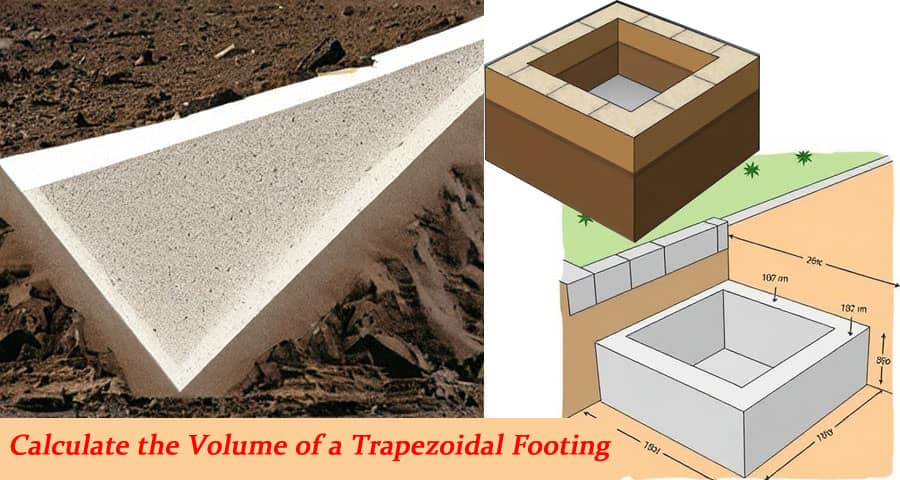Calculate the Volume of a Trapezoidal Footing - A Step-by-Step Guide

A trapezoidal footing is a type of foundation used to support structures on soft or unstable soils. It has four sides with one pair of parallel sides and a non-parallel pair. The size and shape of the footing vary depending on the load it has to bear and the soil conditions. Calculating the volume of a trapezoidal footing is crucial to determine the amount of concrete needed to pour the foundation.
What is a Trapezoidal Footing?
A trapezoidal footing is a type of foundation that has four sides with one pair of parallel sides and a non-parallel pair. It is used to support structures on soft or unstable soils. The shape and size of the footing vary depending on the load it has to bear and the soil conditions. A trapezoidal footing can distribute the load over a larger area and prevent excessive settlement of the foundation.
Why Calculate the Volume of a Trapezoidal Footing?
Calculating the volume of a trapezoidal footing is crucial to determine the amount of concrete needed to pour the foundation. It helps to ensure that there is enough concrete to support the load and prevent excessive settlement. Inaccurate calculation of the volume can result in insufficient or excess concrete, which can compromise the strength and stability of the foundation.
How to Calculate the Volume of a Trapezoidal Footing
Step 1: Measure the Length and Width of the Footing
The first step is to measure the length and width of the footing at the top and bottom. Use a tape measure to get accurate measurements. Record the measurements in feet or meters, depending on your preference.
Step 2: Measure the Height of the Footing
Next, measure the height of the footing from the bottom to the top. Use a measuring tape or ruler to get accurate measurements. Record the measurements in feet or meters, depending on your preference.
Step 3: Calculate the Area of the Footing
To calculate the area of the trapezoidal footing, add the length of the top and bottom sides and multiply by the height. Divide the result by 2 to get the average width. Then, multiply the average width by the height to get the area of the footing. The formula for calculating the area of a trapezoid is:
Area = (a + b) x h / 2
Where: a = length of the top side
b = length of the bottom side
h = height of the footing
Step 4: Calculate the Volume of the Footing
To calculate the volume of the trapezoidal footing, multiply the area by the length of the footing. The formula for calculating the volume of a trapezoidal footing is:
Volume = Area x Length

Tips for Accurate Calculation
Here are some tips to ensure accurate calculation of the volume of a trapezoidal footing:
- Measure the length, width, and height of the footing with precision using a tape measure or ruler.
- Use the correct formula to calculate the area and volume of the footing.
- Double-check your calculations to ensure accuracy.
- Round off the final result to the nearest cubic foot or cubic meter.
FAQs about Calculating the Volume of a Trapezoidal Footing
Why is it important to calculate the volume of a trapezoidal footing?
Calculating the volume of a trapezoidal footing is important to ensure that the correct amount of concrete is used to pour the foundation. Insufficient or excess concrete can compromise the strength and stability of the foundation.
What formula is used to calculate the area of a trapezoidal footing?
The formula for calculating the area of a trapezoidal footing is (a + b) x h / 2, where a is the length of the top side, b is the length of the bottom side, and h is the height of the footing.
What formula is used to calculate the volume of a trapezoidal footing?
The formula for calculating the volume of a trapezoidal footing is area x length, where area is the area of the footing and length is the length of the footing.
Can I use an online calculator to calculate the volume of a trapezoidal footing?
Yes, there are many online calculators available that can help you calculate the volume of a trapezoidal footing. However, it is important to double-check the results to ensure accuracy.
Conclusion
Calculating the volume of a trapezoidal footing is a crucial step in ensuring the strength and stability of a foundation. By following the steps outlined in this guide, you can calculate the volume of a trapezoidal footing with ease and accuracy. Remember to measure the length, width, and height of the footing accurately, use the correct formula, and double-check your calculations to ensure accuracy.
Please watch short video for Trapezoidal Footing Volume Calculation
